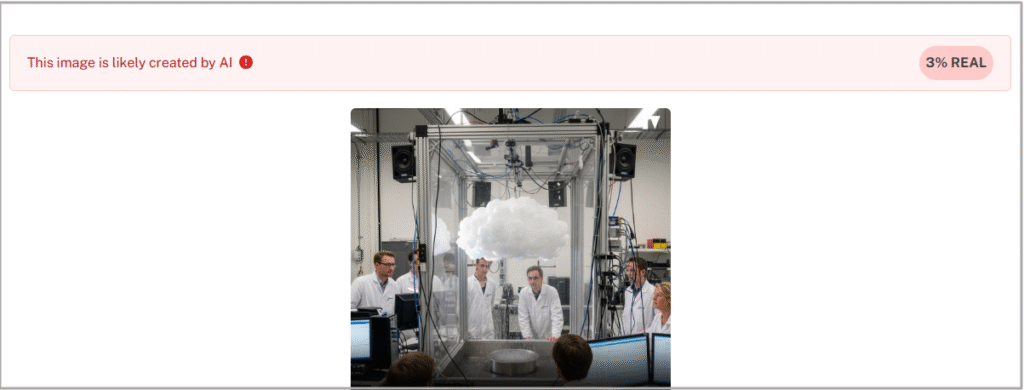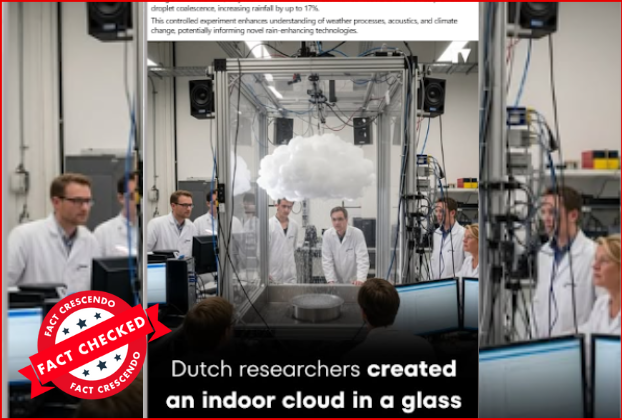In the modern world, various technologies are being used to manipulate the weather patterns as a response to the global climate change. Social media users are talking a lot about it. However, some such social media posts are misleading the public. In this article, we consider the cloud-creating techniques.
Social Media Posts
Recent social media posts claim that “Dutch scientists at TU Delft” built an indoor cloud chamber that actually rains when low-frequency sound is played (50–100 Hz at ~114–121 dB), boosting rainfall by ~17%.

Explanation
We found no evidence from credible sources that any TU Delft researchers performed such an experiment. No TU Delft press release or peer-reviewed paper describes an “indoor rain cloud” system.
And we found that the viral image of the post is most possibly AI-generated.

Source: Undetectable AI
However, there has been research in this field, and below, we are discussing some such research.
In fact, the published studies on acoustic enhancement of droplet coalescence all come from other groups (mostly in China), not TU Delft. For example, a 2021 Applied Acoustics paper on sound‐induced droplet coalescence was authored by Chinese researchers at Tsinghua and other institutes, with no TU Delft involvement. Likewise, a 2021 theoretical study (Journal of Applied Meteorology and Climatology) was authored by scientists in Beijing and Xining, China. In short, the claim misattributes existing research to TU Delft.
What does the research actually say?
Studies confirm that very loud, low-frequency sound can indeed make cloud or fog droplets collide and merge (so-called acoustic agglomeration). Laboratory experiments have shown that cloud‐chamber droplets (~4–20 μm) coalesce under intense sound at ~50–65 Hz and ~114– 121 dB. For instance, Qiu et al. (2021) observed effective droplet agglomeration at those levels.Theoretical analyses agree: one model finds that a 50 Hz sound at ~123 dB will “easily drive” droplets <40μm, and that frequencies below 100 Hz (at ~123 dB) or SPL >117 dB (at 50 Hz) significantly enhance droplet collisions . Another lab study (Ming Zhang et al. 2021) likewise found that sound around 112–122 dB strongly promotes fog‐droplet coalescence. Even so, all these studies stress the extreme volume needed.
A recent preprint on thunder effects notes that below ~120 dB acoustic agglomeration is “not very suitable” (though some effect occurs), and that strong coalescence generally requires >135 dB.
Chinese field experiment (17% rain increase): The “17% increase” figure comes from a 2020 experiment on the Tibetan Plateau by Wang Guangqian’s team (Tsinghua Univ.). They blasted 50 Hz sound at ~160 dB (diesel-driven horn) into real clouds and reported ~17% more rainfall. Importantly, this was an outdoor field test by Chinese scientists, not a TU Delft lab experiment.
Laboratory cloud-chamber studies: In controlled fog-chamber experiments, researchers have generated artificial clouds and then applied sound. For example, Qiu et al. (2021) used a small chamber with microscopic water droplets and found that low-frequency sound (50–65 Hz, ~114–121dB) increased droplet collisions . Other groups (e.g. Bai et al. 2022, Shi et al. 2023) have similarly identified that SPL(Sound Pressure Level)s around 110–120 dB are needed for notable agglomeration. These lab findings do not originate at TU Delft, and typically appear in acoustics or physics journals.
Scientific feasibility of “sound rain”
It is physically possible in principle for sound to enhance droplet coalescence. Experiments and theory agree that low-frequency sound can push small droplets into contact. However, translating this into a practical rain-making technology faces major hurdles:
Very high volumes required. — Effects are only seen at SPLs of order ~110–135 dB or more. (For reference, 120 dB is roughly the noise level of a rock concert or thunderclap close by.) Below ~120 dB the effect is small. Thus, generating sustained ~120–130+ dB sound over large cloud volumes would be extremely challenging and noisy.
Scale and energy issues — Lab “cloud chambers” are small (liters of air), whereas actual clouds cover kilometers. The cited field test used a giant diesel-powered horn (sound ~160 dB at ground) to get ~17% rain boost; such equipment is not easily scaled up or deployed widely. Practical weather control would need enormous acoustic power and would disturb the environment (noise, wildlife, etc.).
Lack of peer-review on “sound rain” at TU Delft–. We found no peer-reviewed publications or official reports from TU Delft on acoustic precipitation enhancement. The idea appears in sensational news sites, but not in validated meteorological research coming from Delft. TU Delft scientists do study clouds and climate, but not via indoor “rain chambers” with speakers as claimed.
Conclusion
The social-media claim is misleading. Similar research on acoustics and droplets exists by Chinese and other groups, but it is not linked to TU Delft. Sound-induced coalescence is a known phenomenon, but it requires extreme sound levels, making any “indoor rain machine” currently more science-fiction than fact. We found no credible source to confirm that “Dutch scientists at TU Delft” have done the experiment described.

Title:Fact-check: “TU Delft indoor cloud” and sound-induced rain
Fact Check By: Fact Crescendo teamResult: Misleading






